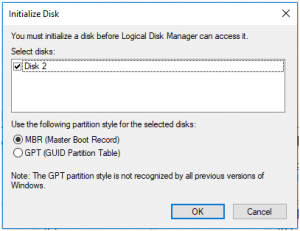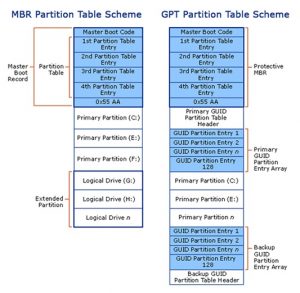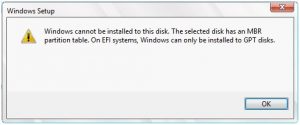MBR vs GPT Guide: What’s The Difference and Which One Is Better

When adding a new HDD or SSD on your computer, it always asked to initialize the disk along with 2 options:
- MBR (Master Boot Record)
- GPT (GUID Partition Table)

Nevertheless, many people have no idea of this choice so that they have to be hesitating when making a choice between MBR and GPT, and they eagerly hope someone could tell them MBR vs GPT, which one is better or which one they should choose.
Have you troubled by such an issue? If yes, this guide is what you are looking for, which clearly introduces the exact difference between MBR and GPT as well as shows how to choose the most proper one for your HDD and how to set on your SSD.
MBR vs. GPT: What’s Their Difference
MBR stands for Master Boot Record while GPT represents GUID Partition Table, and they are 2 partitioning schemes for HDD, SSD and removable devices.
To know what partitioning scheme your hard disk is employing with MiniTool Partition Wizard, which is a freely and help users explore disk/partition properties, initialize disk (to MBR or GPT)
Then, launch the tool to get the main window:

From the screenshot you can see I have just one disk with MBR.
The MBR and GPT are partitioning schemes, and they are doing the same thing: manage how partitions are created and organized on a hard disk, but they differ from each other in many aspects.
Firstly, MBR and GPT Were Introduced in Different Time
MBR was introduced with IBM PC DOS 2.0 in March 1983 and it is used till now. However, GPT was developed in the late 1990s as part of what eventually became UEFI, and it becomes popular just in recent years.
Secondly, MBR and GPT Have Different Structures
MBR consists of 3 parts, including master boot code, a partition table for the disk, and disk signature. A partition table can hold maximum number of 4 entries for primary partitions in Windows.
However, a GUID Partition Table is composed of a Protective MBR which is used in a way that prevents MBR-based disk utilities from misrecognizing and possibly overwriting GPT disks, a primary GUID partition table header which records its own size and location and the size and location of the secondary GPT header, a primary GUID Partition Entry Array, a backup GUID Partition Entry Array, and a backup GUID Partition Table Header. A GUID partition table could contain up to 128 partition entries in Windows.

From the above, you can know a major difference between MBR and GPT, which are the primary partition number on the HDD or SSD. So, if you choose to set MBR or GPT for SSD.
Thirdly, Supports on Disk Capacity and Partition Amounts Are Different
Support on Partition Amounts
Since an MBR partition table can hold 4 primary partition entries at most, you are only allowed to create the maximum number of 4 primary partitions on an MBR disk. If you want to create more partitions, you have to create an extended partition where lots of logical partitions could reside. However, a logical partition can’t be set active.
On the contrary, a GPT disk theoretically allows an almost unlimited number of partitions, but Windows implementation restricts it to 128 partitions. Each partition on GPT can function like a primary partition on MBR disk.
Support on Disk or Partition Capacity
You can only use 2TB or 16TB of a hard disk’s capacity no matter how large the disk is, if you initialize it to MBR. If the disk is using the traditional 512B sector, you can only use 2TB. If it is using 4Kn (4K native) sector, you can use 16TB.
However, a GPT disk can be up to 2^64 logical blocks in length, and logical blocks could be 512 bytes or 4K in size. Therefore, a GUID partition table disk can grow to a very large size compared with MBR partition table disks. Actually, there is no need to talk about disk or partition capacity limit of GPT since there will be no hard disk exceeding the limit in a very long time.
Fourthly, MBR Differs from GPT in Compatibility
All current Windows operating systems can use GPT partitioned disks for data, such as Windows 7, Windows 8, Windows 10, Windows Server 2008, Windows Server 2012, and Windows Server 2016, but only their 64 bit versions support booting from GPT disk when UEFI boot mode is supported and enabled.
In addition, the 32 bit version of Windows XP can only see the Protective MBR, and even the 64 bit version can use GPT disk for data only.
At Last, They Have Different Boot Mode
If motherboard of your computer supports Legacy boot only, you can only boot Windows from MBR disk. To install Windows on GPT disk under this mode, you’ll receive the error message “Windows cannot be installed to this disk. The selected disk is of the GPT partition style“.

Or Windows won’t start if it is already installed on GPT disk under Legacy boot mode.
However, if motherboard of your computer supports UEFI boot only, you can only start Windows from GPT disk. To install Windows on MBR disk, you’ll receive the error message “Windows cannot be installed to this disk. The selected disk has an MBR partition table. On EFI systems, Windows can only be installed to GPT disk”.

Similarly, Windows will be unbootable if it is already installed on MBR disk in UEFI boot mode.
But luckily, current motherboards support both Legacy boot and UEFI boot, so you only need to enable the CSM (Compatibility Support Module) in BIOS when you want to boot Windows from both MBR disk and GPT disk, or enable UEFI when you want to boot from GPT disk, or enable Legacy BIOS while you plan to boot from MBR disk.
In addition, even if your motherboard supports one boot mode only, you can still find solutions from the article Windows Cannot Be Installed to a Disk? Here Are Solutions.Then, let’s talk about which partitioning scheme is better, MBR or GPT.
MBR vs. GPT: Which One Is Better or Which One to Choose
Please read all contents in this part and then choose the most proper partitioning scheme for your SSD, HDD, or even removable device.
GPT is better if you are planning to create more than 4 partitions.
We have said an MBR disk can hold 4 primary partitions at most while a GPT disk supports up to 128 primary partitions in Windows, so you can choose GPT if you want more partitions.
GPT is better than MBR if your hard disk is larger than 2TB.
Since you can only use 2TB of space from a 512B sector hard disk if you initialize it to MBR, you’d better format your disk to GPT if it is larger than 2TB. But if the disk is employing 4K native sector, you can use 16TB space.
GPT is better if you seek for security.
GPT disks use primary and backup partition tables for redundancy and CRC32 fields for improved partition data structure integrity, so you can choose this partitioning scheme if you value data security.
Choose GPT rather than MBR for your system disk if UEFI boot is supported.
Compared with booting from MBR disk, it’s faster and more stable to boot Windows from GPT disk so that your computer performance could be improved, which is largely due to the design of UEFI. Please remember to enter your computer’s BIOS and enable UEFI boot if it isn’t.
Choose MBR for system disk if your motherboard doesn’t support UEFI boot.
Under Legacy boot mode, you can only initialize your system disk to MBR if you want Windows bootable.
Choose MBR as system disk if you have a 32 bit Windows to install.
Only 64 bit version of Windows can boot from GPT disk.
Choose MBR for system disk if you are still using the very old Windows OS.
If you are running Windows XP or older systems, MBR is the only choice for system disk even if it is a 64 bit system. If not, Windows will be unbootable or cannot be installed.
Well, knowing the differences between MBR and GPT, how can you initialize GPT or MBR for SSD or HDD, or convert a disk that already saves data between MBR and GPT without losing data? These are what we will talk in the following part.
How to Initialize Disk to MBR or GPT
It’s very easy to initialize a MBR or GPT for SSD or HDD, which could be done in both Windows Disk Management and MiniTool Partition Wizard.
In Disk Management:
Press on Win and R key to open Run and type diskmgmt.msc to launch Disk Management. Then, you’ll be asked to initialize the newly added hard disk, where you can choose either MBR or GPT.
In MiniTool Partition Wizard:
Launch the program to get its main window:

MiniTool Partition Wizard initializes the newly added disk to MBR by default, but you can select the disk and choose “Initialize to GPT Disk” or “Convert MBR Disk to GPT Disk” feature from the left action panel to convert the disk to GPT if you want GPT. At last, click Apply” button to perform the change.
Bottom Line
Now, all information about MBR vs. GPT is told to you and you would know which partitioning scheme is better to choose. It’s time to initialize GPT or MBR for SSD or HDD or convert old HDD/SSD between MBR and GPT based on the actual needs.



